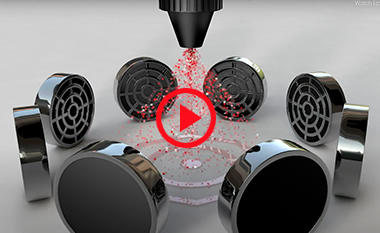|
Lithography is a form of 2D printing. Stereolithography is a type of 3D printing in a layer by layer manner. Technology announced recently describes creating ultrasonic standing waves to control, in air, placement of droplets and particulates on a substrate, that could lead to a new kind of printing.
This technology is called sonolithography. It uses arrangements of ultrasonic transducers, associated equipment and software transducer-driving algorithms to create: "acoustic radiation forces arising from the interference of ultrasonic standing waves to direct airborne particle/droplet accumulation in defined spatial regions." The quotation is paraphrasing the authors description from a recently published research paper1 written by Jenna Shapiro, Bruce Drinkwater, Adam Perriman and Mike Fraser. So an acoustic field placed around the substrate controls the pattern on the substrate like an "acoustic mask."
The authors further state, "Sonolithography is capable of rapidly patterning micrometer to millimeter scale materials onto a wide variety of substrates over a macroscale of 18 cm2 surface area in 30 seconds." Going further, Shapiro et al state that, "using complex sequential patterns including phase changes affecting the ultrasonic standing waves, could be used to create layers of specific particle distributions, much like the slicing function of a 3D printer."1, 2
"The process is 'tunable' so that patterning rate and area can be increased or otherwise adjusted depending on droplet quantity, distance to surface and field strength," according to Jenna Shapiro.
Sonolithography is also flexible in that different materials can be used in the same creation. An example Dr. Shapiro gives is cross-linking monomers/oligomers to create polymers.
Besides potential electronics or possibly mechanical applications, the technology lends itself to biofabrication and tissue engineering. See the video here, scrolling down to the second image to play the video.
The authors are are investigating how dynamically adjusting the acoustic field can create different patterns over time with an eye to building-up complex structures.
Sources: 1. Research paper published in Advanced Materials Technologies
2. Professor Bruce Drinkwater's website
|





